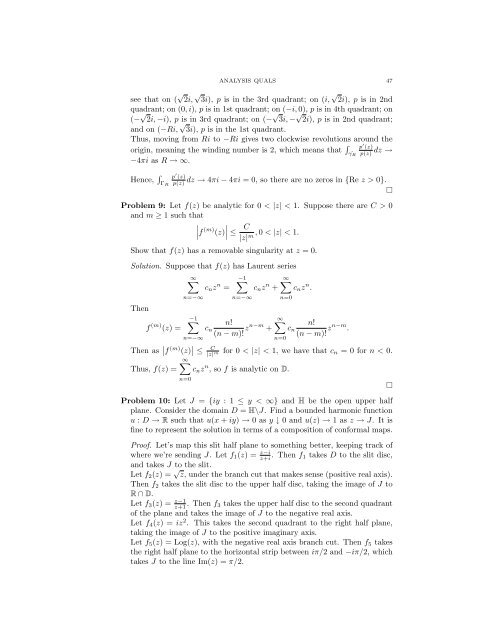ANALYSIS QUALIFYING EXAM PROBLEMS BRIAN LEARY ...
ANALYSIS QUALIFYING EXAM PROBLEMS BRIAN LEARY ...
ANALYSIS QUALIFYING EXAM PROBLEMS BRIAN LEARY ...
You also want an ePaper? Increase the reach of your titles
YUMPU automatically turns print PDFs into web optimized ePapers that Google loves.
<strong>ANALYSIS</strong> QUALS 47<br />
see that on ( √ 2i, √ 3i), p is in the 3rd quadrant; on (i, √ 2i), p is in 2nd<br />
quadrant; on (0, i), p is in 1st quadrant; on (−i, 0), p is in 4th quadrant; on<br />
(− √ 2i, −i), p is in 3rd quadrant; on (− √ 3i, − √ 2i), p is in 2nd quadrant;<br />
and on (−Ri, √ 3i), p is in the 1st quadrant.<br />
Thus, moving from Ri to −Ri gives two clockwise revolutions around the<br />
origin, meaning the winding number is 2, which means that p<br />
γR ˆ<br />
′ (z)<br />
p(z) dz →<br />
−4πi as R → ∞.<br />
Hence, <br />
ΓR<br />
p ′ (z)<br />
p(z) dz → 4πi − 4πi = 0, so there are no zeros in {Re z > 0}.<br />
<br />
Problem 9: Let f(z) be analytic for 0 < |z| < 1. Suppose there are C > 0<br />
and m ≥ 1 such that<br />
<br />
<br />
f (m) <br />
<br />
(z) ≤ C<br />
, 0 < |z| < 1.<br />
|z| m<br />
Show that f(z) has a removable singularity at z = 0.<br />
Solution. Suppose that f(z) has Laurent series<br />
∞<br />
cnz n =<br />
−1<br />
cnz n ∞<br />
+ cnz n .<br />
Then<br />
f (m) (z) =<br />
n=−∞<br />
−1<br />
n=−∞<br />
cn<br />
n=−∞<br />
n=0<br />
n!<br />
(n − m)! zn−m ∞<br />
+<br />
n=0<br />
cn<br />
n!<br />
(n − m)! zn−m .<br />
Then as f (m) (z) ≤ C<br />
|z| m for 0 < |z| < 1, we have that cn = 0 for n < 0.<br />
∞<br />
Thus, f(z) = cnz n , so f is analytic on D.<br />
n=0<br />
Problem 10: Let J = {iy : 1 ≤ y < ∞} and H be the open upper half<br />
plane. Consider the domain D = H\J. Find a bounded harmonic function<br />
u : D → R such that u(x + iy) → 0 as y ↓ 0 and u(z) → 1 as z → J. It is<br />
fine to represent the solution in terms of a composition of conformal maps.<br />
Proof. Let’s map this slit half plane to something better, keeping track of<br />
where we’re sending J. Let f1(z) = z−i<br />
z+i . Then f1 takes D to the slit disc,<br />
and takes J to the slit.<br />
Let f2(z) = √ z, under the branch cut that makes sense (positive real axis).<br />
Then f2 takes the slit disc to the upper half disc, taking the image of J to<br />
R ∩ D.<br />
Let f3(z) = z−1<br />
z+1 . Then f3 takes the upper half disc to the second quadrant<br />
of the plane and takes the image of J to the negative real axis.<br />
Let f4(z) = iz2 . This takes the second quadrant to the right half plane,<br />
taking the image of J to the positive imaginary axis.<br />
Let f5(z) = Log(z), with the negative real axis branch cut. Then f5 takes<br />
the right half plane to the horizontal strip between iπ/2 and −iπ/2, which<br />
takes J to the line Im(z) = π/2.
















